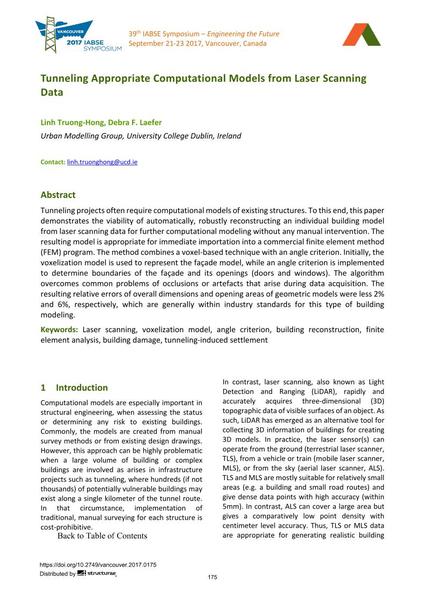Tunneling Appropriate Computational Models from Laser Scanning Data

|
|
|||||||||||
Bibliografische Angaben
| Autor(en): |
Linh Truong-Hong
(Urban Modelling Group, University College Dublin, Ireland)
Debra F. Laefer (Urban Modelling Group, University College Dublin, Ireland) |
||||
|---|---|---|---|---|---|
| Medium: | Tagungsbeitrag | ||||
| Sprache(n): | Englisch | ||||
| Tagung: | IABSE Symposium: Engineering the Future, Vancouver, Canada, 21-23 September 2017 | ||||
| Veröffentlicht in: | IABSE Symposium Vancouver 2017 | ||||
|
|||||
| Seite(n): | 175-182 | ||||
| Anzahl der Seiten (im PDF): | 8 | ||||
| Jahr: | 2017 | ||||
| DOI: | 10.2749/vancouver.2017.0175 | ||||
| Abstrakt: |
Tunneling projects often require computational models of existing structures. To this end, this paper demonstrates the viability of automatically, robustly reconstructing an individual building model from laser scanning data for further computational modeling without any manual intervention. The resulting model is appropriate for immediate importation into a commercial finite element method (FEM) program. The method combines a voxel-based technique with an angle criterion. Initially, the voxelization model is used to represent the façade model, while an angle criterion is implemented to determine boundaries of the façade and its openings (doors and windows). The algorithm overcomes common problems of occlusions or artefacts that arise during data acquisition. The resulting relative errors of overall dimensions and opening areas of geometric models were less 2% and 6%, respectively, which are generally within industry standards for this type of building modeling. |
||||
| Stichwörter: |
Finite-Elemente-Analyse Laserscanning Gebäudeschaden
|
||||
